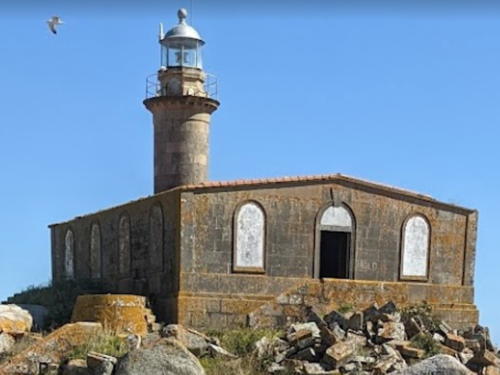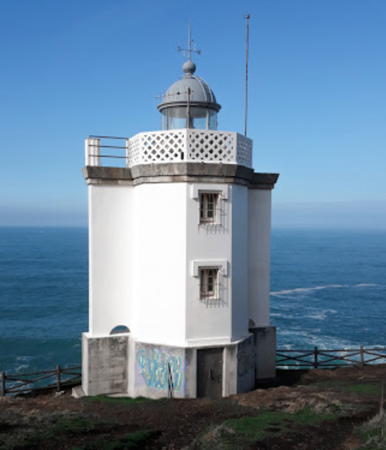The Kingdom of Spain occupies nearly 85% of the Iberian Peninsula in southeastern Europe with coastlines facing south and southeast on the Mediterranean Sea and southwest and northwest on the Atlantic Ocean. Spain also includes the Balearic Islands in the Mediterranean, the Canary Islands in the Atlantic, and the cities of Ceuta and Melilla on the north coast of Morocco.
Spain is divided into 17 regions called autonomous communities (comunidades autónomas). Galicia is an autonomous region in the northwestern corner of Spain. The Galician coastline is rugged and scenic but very dangerous to navigation; it is often called the "Coast of Death" (Costa da Morte in Galego). Many of the harbors are partly-sheltered bays called rías, actually the drowned lower valleys of rivers.
Galicia is divided into four provinces (provincias). This page includes lighthouses of the west coast of the region in southern and central A Coruña Province. The province is divided into county-level districts called comarcas. Lighthouses of the four northernmost districts of A Coruña Province are described on the Northern Galicia page.
Galicians speak Spanish or Galego, a distinctive language related to Portuguese. Galicia itself is called Galiza in Galego. The word for a lighthouse is faro in Spanish and farol in Galego, but its use is generally restricted to the larger coastal light stations. Smaller lighthouses are called balizas (beacons). In Galego illa is an island, cabo is a cape, punta is a promontory or point of land, rocha is a rock, arrecife is a reef, baía is a bay, ría is an estuary or inlet, estreito is a strait, río is a river, and porto is a port or harbor.
The navigational lights in Spain are the responsibility of the national port authority, Puertos del Estado, but many of them are operated and maintained by regional port authorities. The Comisión de Faros, founded in 1842 to build and maintain Spanish lighthouses, is now an advisory panel.
ARLHS numbers are from the ARLHS World List of Lights. ES numbers are from the Spanish national list of lights, Libro de Faros. Admiralty numbers are from volume D of the Admiralty List of Lights & Fog Signals. U.S. NGA List numbers are from Publication 113.
- General Sources
- Libro de Faros y Señales de Niebla
- Online edition of the official Spanish light list.
- Online List of Lights - Spain - Northwest Coast
- Photos by various photographers posted by Alexander Trabas. Some of the photos for this area are by José Da Palma or Eckhard Meyer.
- Faros de Galicia
- A blog on Galician lighhouses posted by Marta Rivadulla.
- Phares d'Europe
- Photos and notes in French by Alain Guyomard and Robert Carceller.
- Lighthouses in Spain
- Excellent aerial photos posted by Marinas.com.
- Lighthouses in Galicia
- Photos by various photographers available from Wikimedia.
- World of Lighthouses - North and West Coasts of Spain
- Photos by various photographers available from Lightphotos.net.
- Navigation Aid
- Information posted by the Porto de Vilagarcía.
- Leuchttürme Spaniens auf historischen Postkarten
- Historic postcard images posted by Klaus Huelse.
- GPSNauticalCharts
- Navigational chart for Galicia.

Torre de Hércules, A Coruña, July 2023
Instagram photo by Torre de Hércules










